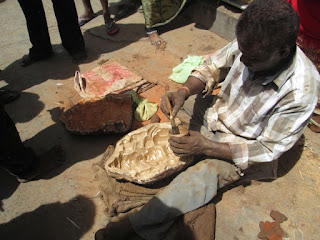One very fascinating aspect of the Navaratri Festival, is the Kolu (Tamil = Golu) which means “Divine Presence”. This celebration incorporates the exhibition or display of dolls and figurines at home and in some cases at Ashrams and public halls.
Below are photographs of the very elaborate, beautiful Kolu display at the ashram of Yogi Ramsuratkumar. If you are hereabouts, do visit the Kolu display, its really quite lovely. So much time and attention has been spent in creating beautiful displays of legends and leelas of Gods and Goddesses.
Kolu figurines can be simple or very complicated and based upon Gods and Saints, depictions of the Epics and Puranas (i.e. Mahabharata, Ramayana, Krishna Leelas etc.), Demigods and National leaders, marriage occasions, musical instruments, shops, current affairs and scenes from everyday life; such as shops, bus stop, cars, street scenes etc.
Historically Kolu had a significant connection with the agricultural economy of Ancient India. In order to encourage de-silting of irrigation canals the Kolu celebration was aimed at providing demand for clay that was needed for the celebratory dolls. It is believed that the tradition of Kolu has been in existence from the reign of the Vijayanagara kings.
There are several sections at the Yogi Ramsuratkumar Ashram within the Kolu displays depicting the abodes, life and legends of various Gods and Goddesses.
 |
| Devotees visiting the 2016 Ashram Kolu Display |
 |
| Gods and Saints ranged on tiered platforms |
 |
| Section dedicated to the story of Krishna |
 |
| Various leelas and legends of the Krishna Avatar |
 |
| All the displays have been loving and carefully created |
 |
| Vishwarupa Dharsanam of the Bhagavad Gita |
 | |||
| The Five Pancha Bootha Sthalams |
From left to right the five pancha bhoota sthalams:
Kanchipuram
Thiruvanaikaval
Tiruvannamalai
Kalahasthi
Chidambaram
 | ||
| Section dedicated to the Six Abodes of Lord Murugan |
Lord Murugan is much beloved in these parts and in the Kolu Display there is a special section dedicated to His six abodes.
Those six abodes are:
Thirupparamkunram: Located on the outskirts of Madurai on a hillock where Kartikeya married Indra's daughter Deivanai.
Tiruchendur: Located on the sea-shore near Tuticorin. The Temple commemorates the place where Murugan worshiped Lord Siva and won a decisive victory over demon Soorapadman.
Palani: Located south east of Coimbatore, the Temple is build on a hill top where Murugan resided after his feud with his family over a divine fruit.
Swamimalai: Located at 5 km from Kumbakonam, the Temple is built on an artificial hill and . commemorates the incident where Lord Murugan explained the essence of "Om" to his father Lord Siva.
Thiruthani: Located near Chennai, Murugan reclaimed his inner peace after waging a war with Asuras and married Valli here.
Pazhamudircholai: Located on the outskirts of Madurai on a hillock with a holy stream nearby called "Nupura Gangai".
 |
| Section dedicated to the history of Yogi Ramasuratkumar |
 |
| Yogi Ramsuratkumar's Ashram |
 |
| Blessed Arunachala |
[Photographs courtesy of Mr. Hari Prasad]
There is so much more to see than what I have posted. As always the Navratri Kolu Display at Yogi Ramsuratkumar Ashram has been created with great love and devotion. If you are either living at Tiruvannamalai, or visiting at this time, do please visit this wonderful and inspirational Display.








































